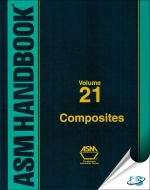Tab Article
ASM Handbook, Volume 21 : Composites provides a comprehensive, practical, and reliable source of technical knowledge, engineering data and supporting information for composite materials. This handbook is intended to be a resource volume for non-specialists who are interested in gaining a practical working knowledge of the capabilities and applications of composite materials. Thus, coverage emphasizes well-qualified and useful information for materials that can be produced in quantities and product forms of engineering significance. The full range of information of importance to the practical technologist is provided in this volume, including forms and properties of constituent materials, mechanics and design, processing, post-processing and assembly, testing and analysis, quality control, testing and certification, properties and performance, maintenance and repair, failure analysis, recycling and disposal, and applications.
Coverage is provided of all commercially significant types of composites, including polymer- and other organic-matrix composites (OMCs), metal-matrix composites (MMCs), and ceramic-matrix composites (CMCs). Coverage is provided in a balanced fashion that is proportional to the maturity and use of each material class.
The handbook is a completely revised and updated version of the Engineered Materials Handbook, Volume 1: Composites, published by ASM International in 1987. Information on OMCs has been updated to reflect advancements in this technology field, including improvements in low-cost manufacturing technologies and significantly expanded applications in areas such as infrastructure. Progress in MMCs has been particularly dramatic since the previous edition, and new information on these materials provides an up-to-date comprehensive guide to MMC processing, properties, applications, and technology. CMCs have also entered service in a number of applications since the previous edition, and these advances are described in the volume.
Over 300 international experts from industry, academia, and military research facilities contributed as authors and reviewers to this handbook.


